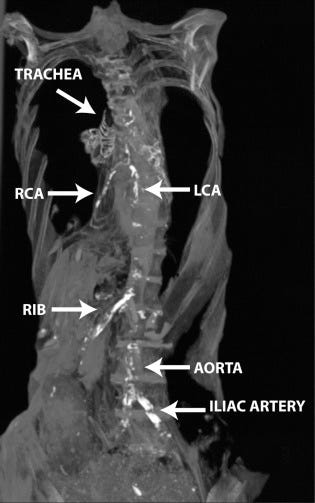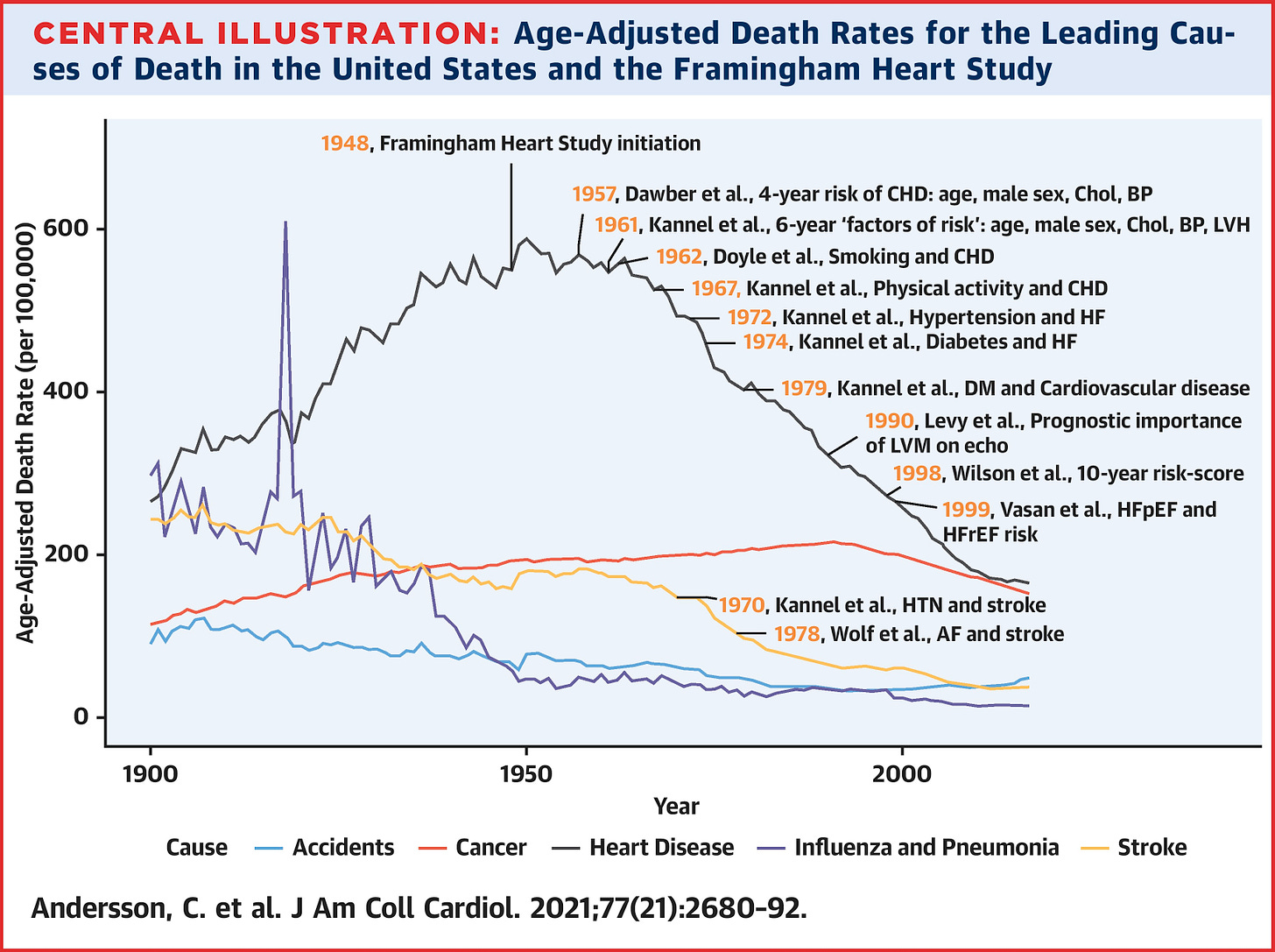Is Heart Disease A Condition Of Modernity?

Was our cardiovascular health much better in the past?
With our modern world incentivising such unhealthy behaviours, it might appear that now more than ever, we are seeing an epidemic of heart disease.
In reality, however, heart disease has been around for thousands of years, and although it remains the leading cause of death worldwide, we are actually doing far better than most people think.
Here’s why.
Calcification is one of the hallmarks of coronary artery disease and its presence on a CT scan in the area of a blood vessel typically reflects plaque buildup. The more calcification, the greater the amount of plaque.

As you can see from the above scan the white areas reflect calcification indicating plaque buildup that can be found in blood vessels including the aorta, the iliac artery and the left and right coronary arteries (LCA & RCA). It is also found outside of blood vessels eg the trachea1.
As CT scans go, this isn’t very unusual and would be fairly typical for any older person.
But this is a CT scan of a 4000-year-old mummy of an Egyptian Princess scanned as part of an investigation called the Horus study.

The Horus study looked to compare levels of plaque build-up in the arteries of modern-day Egyptians and their 4000-year-old ancient counterparts.
The study demonstrated that plaque buildup (Atherosclerosis) was relatively common in Ancient Egypt, even in those less than 40 years of age.

Yes, of course, those who were entombed in vaults would have lived very different lives compared to those who were not Egyptian royalty. But it nicely illustrates plaque buildup in human arteries is not just a modern phenomenon.
It has been with us for millennia.
So let’s fast forward a few thousand years.
Although heart disease kills a lot of people at an early age today, it killed a whole lot more for most of the 1900s.

Why death rates rose so spectacularly in the early 1900s and then started to plummet from the 1970s onwards is a complex topic, but I suspect it is largely driven by a decline in smoking rates.
There are likely many factors at play, however, that are nicely outlined in the graphic below, including our understating of the relationship between cholesterol, high blood pressure, diabetes and cardiovascular disease2.

What is staggering to realise is that in developed nations such as the United Kingdom, the death rates from cardiovascular disease have dropped by 75% over the previous 60 years3.
“The future is here; it is just not very evenly distributed.”
William Gibson
While the rate of progress has been impressive, not all areas have benefited equally. For example, those in Glasgow, a less affluent region of the United Kingdom, are still three times more likely to die prematurely from cardiovascular disease compared to their counterparts in the South East of the UK.
South American Tsimane Tribe
While cardiovascular disease is not a recent phenomenon, and we have made substantial progress, there remain exemplars where the disease is almost absent in the population.
As mentioned above, calcification in a blood vessel is often a hallmark of atherosclerosis. Assessing the amount of calcification/atherosclerosis can be done using a CT Calcium Score. A score of 0 indicates no calcified plaque, and a score of above 0 indicates some plaque.
A CT Calcium score greater than 100 or above the 75th percentile is typically considered an indication of enough plaque to increase the risk of a heart attack over a 10-year time frame.
The MESA cohort is a representative sample of US adults for whom we know their CT Calcium score, and this gives us an indication of their future cardiovascular risk.

As you can see, for both males and females, the older one gets, the higher the likelihood you will have a calcium score greater than 100 or above the 75th percentile.
This also fits with our understanding that age is the most significant risk factor for cardiovascular disease. The older you are, the more plaque you are likely to have and, therefore, the higher your risk of a heart attack or stroke.
But let’s look at another modern-day group of adults; the Tsimane Tribe of Bolivia. These modern-day hunter-gathers have also had assessments of their calcium scores, and the results are pretty surprising.

As you can see the proportion of those with a calcium score above 100 or the 75th percentile is almost negligible. This is why the Tsimane Tribe have possibly the lowest rates of cardiovascular disease worldwide. The reason for their low rates of cardiovascular disease is likely down to the very low rates of obesity, high blood pressure, diabetes, high cholesterol and low smoking rates.
Atherosclerosis - Modern or Ancient?
What is clear is that coronary artery disease is by no means a modern phenomenon.
But just because you are a modern human does not guarantee you will develop cardiovascular disease at a young age, as is so nicely illustrated by the low rates in the Tsimane Tribe of Bolivia.
I am not suggesting we all become South American hunter-gathers to reduce our risk. Still, we can learn from them that optimising all our cardiovascular risk factors significantly decreases our lifetime cardiovascular risk.
Early heart disease does not have to be inevitable.
We just need to know how to tilt the odds in our favour.
More Tsimane Tribe.
Less Egyptian Royalty might be the way.
Atherosclerosis in ancient and modern Egyptians: the Horus study. Glob Heart. 2014 Jun;9(2):197-202.
Framingham Heart Study: JACC Focus Seminar, 1/8. J Am Coll Cardiol. 2021 Jun 1;77(21):2680-2692.
https://www.bhf.org.uk/-/media/files/research/heart-statistics/bhf-cvd-statistics---uk-factsheet.pdf




